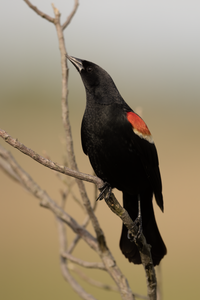
Photo from wikipedia
Background Assessing outcomes of habitat management is critical for informing and adapting conservation plans. From 2013-2019, a multi-stage management initiative, led by the American Bird Conservancy (ABC), aims to create… Click to show full abstract
Background Assessing outcomes of habitat management is critical for informing and adapting conservation plans. From 2013-2019, a multi-stage management initiative, led by the American Bird Conservancy (ABC), aims to create >25,000 ha of shrubland and early-successional vegetation to benefit Golden-winged Warblers (Vermivora chrysoptera) in managed forested landscapes of the western Great Lakes region. We studied a dense breeding population of Golden-winged Warblers at Rice Lake National Wildlife Refuge (NWR) in Minnesota, USA, where ABC initiative management was implemented to benefit the species. Methods We monitored abundance before (2011-2014) and after (2015-2016) management, and we estimated full-season productivity (i.e., young recruited into the fall population) from predictive, spatially explicit models, informed by nest and fledgling survival data collected at sites in the western Great Lakes region, including Rice Lake NWR, during 2011 and 2012. Then, using biologically informed models of bird response to observed and predicted vegetation succession, we estimated the cumulative change in population recruitment over various scenarios of vegetation succession and demographic response. Results We observed an 32% decline in abundance of breeding pairs and estimated a 27% decline in per-pair full-season productivity following management, compared to no change in a nearby control site. In models that ranged from highly optimistic to progressively more realistic scenarios, we estimated a net loss of 72-460 juvenile Golden-winged Warblers produced from the managed site in the 10-20 years following management. Even if our well-informed and locally validated productivity models produced erroneous estimates and the management resulted in only a temporary reduction in abundance (i.e., no change in productivity), our forecast models still predicted a net loss of 137-260 juvenile Golden-winged Warblers from the managed area over the same time frame. Conclusions Our study site represents only a small portion of a massive management initiative; however, the management at our site was conducted in accordance with the initiative's management plans, the resulting vegetation structure is consistent with that of other areas managed under the initiative, and those responsible for the initiative have described the management at our study site as successful Golden-winged Warbler management. Our assessment demonstrates that, at least for the only site for which pre- and post-management data on Golden-winged Warblers exist, the ABC management initiative is having a substantial and likely enduring negative impact on the species it purports to benefit. We suggest that incorporating region-specific, empirical information about Golden-winged Warbler-habitat relations into habitat management efforts would increase the likelihood of a positive response by Golden-winged Warblers.
Journal Title: PeerJ
Year Published: 2018
Link to full text (if available)
Share on Social Media: Sign Up to like & get
recommendations!